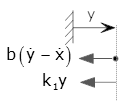Example: Deriving a single nth order differential equation from coupled equations
Consider the system shown with fa(t) as input and x(t) as output. Find the differential equation relating x(t) to fa(t).

We can write free body equations for the system at x and at y.
| Freebody Diagram | Equation |
 |
 |
 |
 |
Take the Laplace Transform of both equations with zero initial conditions (so derivatives in time are replaced by multiplications by "s" in the Laplace domain).

Now solve the second equation for Y(s) and substitute into the first equation and clear the fractions (so there are only positive powers of s).

Convert back to differential equation (replacing "s" in Laplace by a derivative in time).
